CATACOMB OF TERROR
|
|
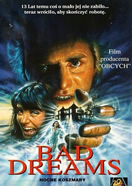 |
BAD DREAMS 1988. Directed by Andrew Fleming A surprisingly good film from an era that vomited forth more than its fair share of crapulence. This film, about a sinister cult leader and his vulnerable victims, rings many home truths about the David Koresh tragedy and as a result, adds to the horror value. The film is set in the mid-70's and begins with the leader of the Unity Fields love cult, one Franklin Harris (Richard Lynch), encouraging his followers to make the ultimate sacrifice by dousing themselves in gasoline and indulging in a mass suicide. A mass blaze ensues, one young girl, Cynthia Weston (Jennifer Rubin) survives and after 13 years in a coma eventually returns to the land of the living. Alas, all is not as it seems, as Cynthia is haunted by the ghost of the ex-leader and all manner of gruesome events come to entertain our blood lusting peepers. As part of an experimental psychiatric group led by Dr Alex Karmen (Bruce Abbott) Cynthia is introduced to several sad and disturbing characters which only adds to the intrigue of the film. The resurrected Harris wants to stir up some gore and get his 'chosen one' to cross over into the dark side. Throughout the escapade a tension builds and the corruption of a Dr Berrisford (Harris Yulin) adds an extra slab of sinisterism to the flow. Come the end, it is gratifying to see a few characters get their comeuppance. A very stable and watchable film with efficient acting throughout and a nicely paced flow had. The psychological weight of the film backs up the general unease felt and although not making the 'classic' standard this is more than just an average affair. |
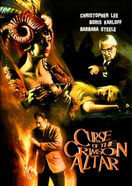 |
CURSE OF THE CRIMSON ALTAR 1968. Directed by Vernon Sewell. A film that features one of the last appearances of irreplaceable Boris Karloff this lame effort at terror is a pure let-down for both the cast and those taking time to indulge. The title is well-known to all horror obsessed dabblers, the image of Barbara Steele is one well-used in horror tomes, I just wonder how many have looked forward to viewing this and come away disappointed? The plot revolves around antiques dealer Robert Manning (Mark Eden) who goes in search of his brother in the tucked away realms of Craxted Lodge at Greymarsh. Upon arrival he is invited to join a swinging party held by Eve (Virginia Wetherell) who is the niece of the owner Morley (Christopher Lee). Manning, who believes his brother stayed at the house questions Morley who denies all knowledge but some strange dreams concerning ritual sacrifice keep Manning's suspicions aroused. Explanations as to the sinister events come via occult expert Robert Marsh (Boris Karloff) with ancestral witchcraft exposed. Lavina (Barbara Steele) is one of Morley's ancestors and renowned for dabbling in the black arts, as the film progresses we come to discover that the powers of the occult will not be denied and certain innocents are involved. Come the end of the 89 minutes running time I was more than happy to praise the joy of the finale and the usual cornball closure. As said, with such a cast including Michael Gough and Rupert Davies this should have been something special, what we get is nothing more than a slow-paced effort that is a trifle disjointed and lacking any chills or thrills. |
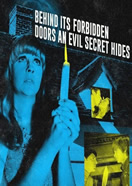 |
THE HAUNTED HOUSE OF HORROR 1969. Directed by Michael Armstrong. A 60's sub-teen horror with a storyline that has been whipped ragged over many years. Many familiar faces pop up (one of which is Veronica Doran who played the girlfriend of Eddie Yates in Coronation Street) with the acting is all rather staged. I enter the realms of promised terror, but I came away disturbed for all the wrong reasons. The tale is set in the time when London was swinging although the dreadful party that introduces us to the films main characters is barely reflective of this. After getting bored by proceedings a small group of youthful bods set off for some 'kicks' at a local haunted house. In the mix are Chris (Frankie Avalon) and his girlfriend Sheila (Jill Haworth), the untrustworthy oil-ball Gary (Mark Wynter) and his piece for the night Dorothy (Carol Dilworth), edgy Madge (Veronica Doran), hot-head Peter (Richard O’ Sullivan), baby-faced Richard (Julian Barnes) and his mate Henry (Robin Stewart). On their tail is the recently snubbed now-ex older boyfriend of Sylvia, namely Paul Kellett (George Sewell). The crew of thrill-seekers hold a seance, Sylvia gets the heebie-jeebies and leaves and although Kellett watches her hitch-hike a lift he stays behind at the mansion. From here we see a murder, suspicions that the killer is part of the group and all manner of shady goings on ensue matched only by the very shady acting. After a brutal knifing the group flee, but stupidly return to dispose of the body which may land them in hot water with local Inspector (Dennis Price). The run down to the finale is average fare and the lack of excitement leaves one just wishing for the closing credits. The only highpoint is a stab in the genitals for one of the most annoying characters - cinematic justice indeed. A cut-price hotchpotch affair outshone by an abundance of far better productions all dealing with the same spooky setting and 'whodunnit' scenario. The title once again promises much, the content though fails to deliver, oh bugger it! |
 |
DR BLOOD'S COFFIN 1975. Directed by Sidneu J. Fury Another film about a mad doctor who plays the role of self-appointed God and duly believes he has the power to take and give life whenever and wherever he sees fit. Shot in Cornwall the whole affair has a decent atmosphere that helps override the slow unfolding of the plot. Down in the Cornish village of Porthcarron Doctor's surgeries are being robbed and people are going missing. Enter Dr Peter Blood (Kieron Moore) a dubious character who has returned from Vienna after working in biochemistry. Blood's father Robert (Ian Hunter) is the local doctor and his assistant is an attractive widowed nurse known as Linda Parker (Hazel Court) - it goes without saying Peter and Linda are rather attracted to one another. The recent crimes are being investigated by Police Sgt Cook (Kenneth J. Warren) who is aided by Dr Blood. Tin Mines are explored, the latest missing man, George Beale (Andy Alston) is found by Blood who is obviously the guilty party in these strange events. Before the Sergeant has a chance to question Beale he is injected by Blood who pronounces him dead. The murderer thinks he has covered his tracks but a few careless errors arouses suspicion with Linda now a trifle on edge. As we enter the later stages of the film we are shown Blood's true motives and a few gory scenes and outbursts reveal a man unhinged and with an arrogant streak that overrides any empathy for his victims or those who get in his way. We finally enter the end scenes with some superb zombie action a real treat for those lovers of the undead. The staggering corpse-like creature is neatly delivered and the fact that it is Linda's ex-husband only adds to the horror. This hackneyed film is a slow boiler and had the potential to be something utterly memorable. Overall it is just an average horror jaunt that is partially rescued by a quality end showdown. Throughout the running time a certain style and quality of execution is lacking and at times the film just seems to go through a routine. The odd flashing scalpel and flash of gore though will appeal to the oglers of the gruesome, so all is not lost. |
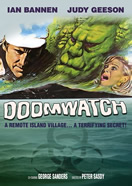 |
DOOMWATCH 1972. Directed by Peter Sasdy A very convincing British film that has an adequately delivered storyline with good pace and some decent acting performances. There is something earthy and effective here and in these days of foul pollution the theme holds up with strong pertinence. Set in Cornwall the story revolves around Dr Del Shaw (Ian Bannen) of the British Ecological Group (nicknamed Doomwatch) and his investigations on the island of Balfe after a recent oil spill. The resident people of Balfe are a hostile and abrupt bunch with many sporting seeming hereditary defects in the form of bulging brows and thickened lips. As Shaw investigates further its seems the folk are affected by a hormonal disorder brought about by an offshore dumping of growth stimulants that have got into the food supply. The end result is people with Acromegaly-like symptoms as well as a streak of madness and aggression. Shaw is in the midst of a real problem and only has local teacher Victoria Brown (Judy Geeson) for morale support. The story slowly unwinds and come the end we have a satisfying film with a certain warning in the mix. The Wickerman-like behaviour of the locals, the underplayed style of the film and the subdued tones make this a fascinating and rewarding watch with the horror element subtly delivered. Sometimes it isn't all about blood and guts and now and again we do need to be made to think. |
 |
URBAN LEGEND A modern horror from the slack-jawed 90's when much of the usual slash and stalk ingredients were regurgitated, glossed up and palmed off on an audience surely starved of quality. The main focus of the plot revolves around Pendleton University where a series of grisly murders take place, all to the dismay of our lead girl and goody two-shoes Natalie Simon (Alicia Witt) and several of her friends. One by one the body count builds with a University Journalist keen to stick his nose in and get all the gen on the going's-on. The usual tick-box kids are thrown into the mix with hormones racing and sarcastic wisecracks abundant. As the tale develops several suspects are pushed to the fore and then killed so as to keep the guessing game (and hopefully interest) high. As it turns out, the killer isn't who you think it is and, comethe end, the only shock had is that this filmed spawned several sequels. With Robert Englund starring as a University Lecturer, some good camera work and the potential for a real gore fest, the film deflates on all levels and is, for me at least, a real turkey. I began the film with high hopes, I finished it noting that another two hours of my time has been wasted on another late 20th century horror - it seems par for the course. |
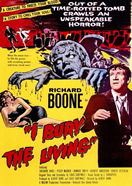 |
I BURY THE LIVING 1958. Directed by Albert Band. An atmospheric movie built on psychological tension and a fantastical turn of events that confuse coincidence, corruption and deception. A large, forbidding cemetery is overseen by newly appointed chairman Robert Kraft (Richard Boone) along with quirky caretaker Andrew MacKee (Theodore Bickel). In the main office is a large map that signifies where filled graves are found (black pins) and where sold graves are located (white pins). Kraft accidentally inserts two black pins in the wrong place and then discovers that the couple who had purchased the graves have died in a car accident. Our lead man is immediately unsettled and believes his mistake brought about their fate. Several more black pins are put in the wrong place on purpose to try and quell Kraft's own worries, the outcomes however only send him into deep, mental turmoil. Convinced of some hidden power over life and death Karft next places white pins where the black pins where believing from death he can indeed bring life. When he examines the graves marked out for this latest experiment he finds all are open and empty. The tension builds and one expects a zombie explosion, however what one gets is something a lot tamer and more realistic. The film here has a Romero-esque feel and some solid sinisterism running throughout. The lead up to the finale is spot on with only the end result marring matters. I feel with a full-on 'revenge of the living dead' finale we could have had a classic on our hands but what we get is an above average episode of suspense. |
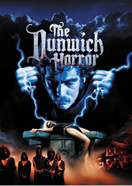 |
THE DUNWICH HORROR 1970. Directed by Daniel Haller An American International Picture based on the scribblings of the master of suggestion H. P. Lovecraft. I didn't expect much here, but what I got was a creepy treat with one or two unsettling moments. An opening sequence deals with a strange birthing process and then we are carried forward in time to Arkham, Massachusetts where Dr Henry Armitage (Ed Begley) has finished a lecture on the Necromonicon and asked one of his students, Nancy Wagner (Sandra Dee), to return it to the library. Enter Wilbur Whateley (Dean Stockwell), a strange and sinister man with a desire to get his hands on the pricless book so as to help him bring back The Old Ones. Nancy is drawn into the hypnotic ways of Whateley, ends up back at his house where all manner of oddness occurs. A strange Grandad (Sam Jaffe), a living entity in an upstairs cupboard and nerve-racking sounds all come into play whilst Whateley seduces Wagner and sets about using her as a means to reincarnate many darkened forces. The locals become unhappy, after Whateley's Grandad dies they refuse to let him be buried in their local graveyard and soon after, they are on the trail of a madman hell-bent on summoning the darkside. The final showdown may be a little laughable but it rounds off things in adequate style. This is a steady flowing film that in parts has some shady acting, some garish effects and one or two moments of creeping suspense. The lead maniac is as greasy and as selfish as they come, the attack via the locked room is stunning and the psychedelic imagery is neatly delivered. A minor surprise despite the low-budget aspects of the film. |
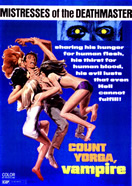 |
COUNT YORGA, VAMPIRE 1970. Directed by Bob Kelljan A slow-moving film that has many cinematic facets to ponder and a decent low-budget atmosphere to flow with. It is a blatant twist on the Dracula theme and in my opinion is done with subtlety and a certain degree of success. The Hungarian Count Yorga (Robert Quarry) has been invited to Low Angeles to lead a séance. A lady known as Donna (Donna Anders) wishes to contact her dead mother and so the count is called upon to use is mystical skills. After hysterical outbursts the Count leaves with Donna's friends Erica (Judy Lang) and Paul (Michael Murphy). Erica is rather smitten with the mysterious one although after dropping off the Count she manages to find time to make love to Paul in their rather hippy-ish van. The loved-up scenario is soon ruined though as Yorga appears and attacks the couple. The next day the couple are back in town where Paul tells Donna's boyfriend Michael (Mike Thompson) about the attack and Erica visits a Dr Hayes (Roger Perry) to get some strange bite wounds on her neck checked out. Suspicions are soon stoked into flames of certainty and after several unsettling events (including a cat-consuming incident) the 3 lead men are convinced Count Yorga is a blood-sucking nightmare. Events unfold and the showdown comes at the sub-gothic mansion where the Count dwells with his trio of vampiric vixens and his disturbed and disfigured henchman Brudah (Edward Walsh). The closing stages have good imagery and a certain tension although the downfall of the Count is somewhat weak and I feel, slightly rushed. Quarry plays out the role of head vampire here with convincing accuracy and brooding malevolence. Yorga is a man laden with self-assuredness and a somewhat troubled underlayer of emotion that really ensnares the attention. Thank goodness the director's avoided the soft porn route with this film which I think would have taken the edge off an above average horror jaunt. |
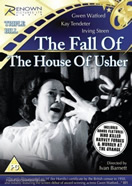 |
THE FALL OF THE HOUSE OF USHER 1950. Directed by Ivan Barnett The famous Poe tale goes under the cinematic spotlight in this early retelling of the original classic. The tale is related by a member of a Gentlemen's Club and is played out in a very theatrical style. A young man called Jonathon (Irving Steen) visits a remote and disturbing mansion whereupon he meets the accursed Lord Roderick Usher (Kaye Tendeter) and his sister Madelaine (Gwendoline Watford). The couple are ill - both mentally and physically it seems with Usher himself a nervous man suffering from an acuteness of the senses. It seems a curse has been brought on the family after their father kills his wife's lover and leaves his partner to a life of loneliness. In a nearby temple we come across the aging wife (Lucy Pavey) who is both mentally deranged and physically abhorrent. After Madelaine dies, Roderick's mind snaps and the finale sees all characters come together and bring about an expected closure. We are left with several questions unanswered but in a world of madness, such is the case. A very stagy and deliberate offering this with all players somewhat wooden and hammy. Despite these faults the film is atmospheric and neatly shot with one or two moments very eerie and quite disturbing - not least the old hag who prowls with evil intent. |